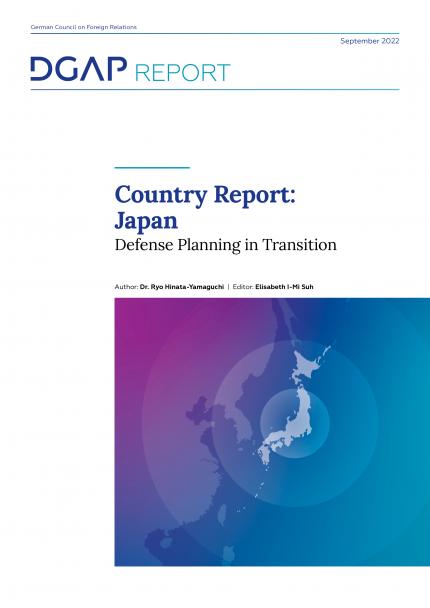Please note: below you find the executive summary of the report. For the full report, including footnotes and graphics, please download the pdf here.
Understanding Japan’s defense strategy and readiness is vital not simply because the nation is a key global player, but also because of its proactive role in the Free and Open Indo-Pacific initiative that it pursues together with the United States and likeminded states. Equally, it is vital to understand the political, bureaucratic, economic, and historical context that explain the characteristics of Japan’s defense planning, but also what it can and cannot do. While the JSDF was established in 1954, it was not until the 2000s that real efforts to sharpen and strengthen its defense posture to deal with the growing threats from China, North Korea, and Russia were made. From 2013, Japan took new steps, particularly by institutionalizing and systemizing its national security with the establishment of the National Security Council and the NSS.
The developments in Japan’s defense readiness over the past decade or so have been notable. There have been significant enhancements of the defense of remote islands, strike capabilities, missile defense, and of capabilities for operations in the cyber, outer space, and electronic domains. As Japan works to compose the 2022 NSS and NDPG, several elements are under discussion, including counterstrike capabilities and operations, asymmetric capabilities for sea control and denial, readiness against hybrid warfare, establishment and enhancement of joint commands and operations, and information security. Moreover, some hardliners remain curious with regard to nuclear armament or nuclear sharing with the United States. While either are unlikely to materialize in the immediate term, they do reflect a new tone in the debate concerning national defense.
The developments to date and those going forward pivot on three points: First, Japan has increased its use of the JSDF for national security, moving from minimalist involvement to proactive mobilization in order to defend the nation’s strategic frontiers. At the same time, it has en-hanced cooperation and coordination with the United States and likeminded states. Second, it has increased the levels of offensive capabilities and operations to deter and defend against the threats it faces. Third, Japan has significantly enhanced the joint capabilities and operations of the three JSDF branches.
Still, several factors constrain further implementation of the measures needed. First, significant barriers remain not only due to Article 9 of the constitution (the “no war” clause) but also because of rigid bureaucratic structures and processes. Also, the debate on defense remains under-developed in Japan. Second, budgetary constraints have long been a problem, and even though Tokyo is working to lift the self-imposed cap of one percent of GDP for defense outlays, financing improvements to the JSDF’s readiness will remain a problem in the coming years. Third, there are human resource problems largely due to the nation’s demographic crisis, leading to not only a simple shortage of personnel, but also to an uneven distribution of staff among the JSDF branches.
While many of these issues must be addressed domestically, Japan also needs to deepen and expand cooperation with the United States and likeminded countries in Asia and Europe. Work should focus on combined or coordinated strategies and operations, but also compatible standards for information sharing and technological transfers. At the same time, Japan should engage in constructive diplomatic and collective security efforts with regional partners. The goal should be to establish sustainable arms control, improve regional cooperation and conflict prevention, and strengthen the rules-based order.
For European stakeholders, the paper makes three key recommendations: First, deepen and regularize high-level dialogues between Japan and NATO to discuss priorities and plans for the partnership. Both sides should also invite their partner to participate in selected defense exercises. Second, deepen bilateral security relations between Japan and key NATO states and take advantage of the specific characteristics and strengths of the partnerships. Third, expand security partnerships to include exchanges and the joint development of new and emerging technologies. Progress on all three elements is vital if Japan and its European and NATO partners wish to be able to protect their shared interest in democracy, prosperity, and the rules-based order in the Indo-Pacific and the Atlantic.
ABOUT THE PROJECT
The DGAP’s project on “Risk Reduction and Arms Control in the Asia-Pacific Region” aims to provide a comprehensive analysis of the security dynamics in the In-do-Pacific and East Asia, with a focus on important players including Australia, China, Japan, North Korea, Russia, South Korea, Taiwan, and the United States. The objective is to foster understanding in Germany and Europe of the risk of conflict in the Asia-Pacific and suggest possible steps to mitigate this risk and safeguard stability in and beyond the region. The project starts with taking stock of security developments in the Asia-Pacific. As part of a series, the following report provides a detailed review of Japan’s security and defense policies and partnerships in the current geopolitical context. It concludes with a list of policy recommendations to stakeholders and policymakers.
DISCLAIMER
This report does not contain new empirical findings but assesses primary documents and compiles existing studies, primarily from expert sources. It is tailored for a European audience.




